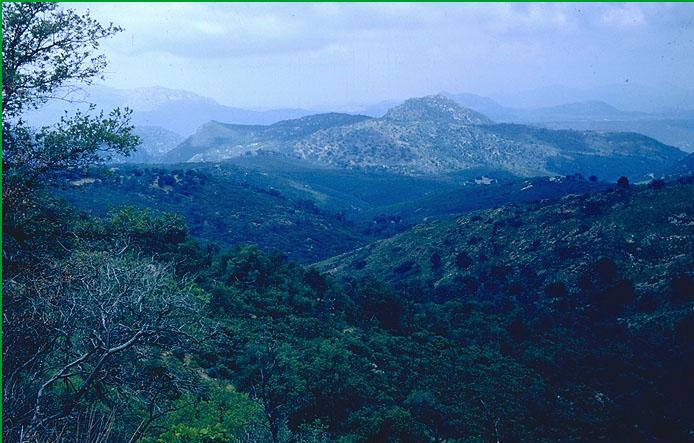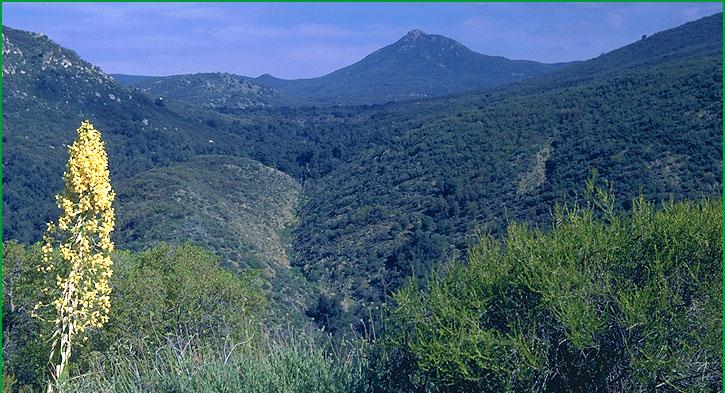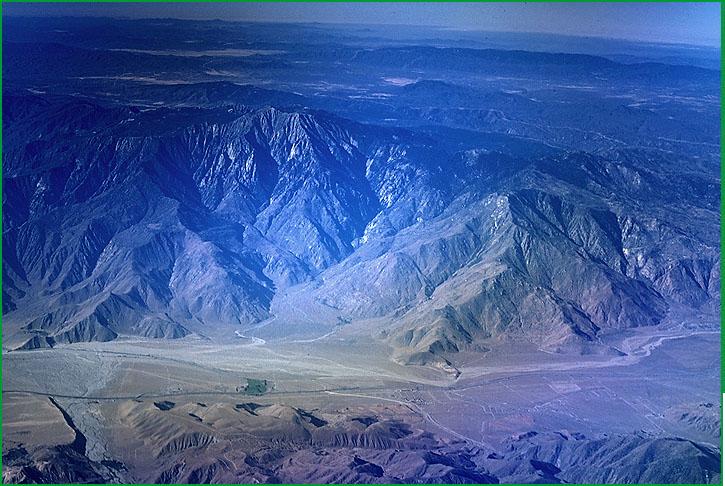 | San Jacinto Mountains- Western Granitic Foothills- Palomar - Cuyamaca Peak- Desert Slopes |
Western Granitic Foothills- Pine Hills area, Inaja Indian Reservation Ś Robert Ettner |
Palomar - Cuyamaca Peak-Corte Madera area Ś Robert Ettner |
Desert Slopes - view toward Anza-Borrego State Park from Laguna Mountains Ś Robert Ettner |
http://www.fs.fed.us/r5/projects/ecoregions/m262bm.htm
Subsection M262Bm
San Jacinto Mountains
This subsection consists of the higher and cooler parts of the San Jacinto and the Cahuilla Mountains. The climate is temperate to cold, and subhumid; it is affected by elevation much more than by marine influence. MLRAs 22d and 22e.
Lithology and Stratigraphy. The San Jacinto Mountains contain mostly Mesozoic granitic rocks and the Cahuilla Mountains contain mostly Pre-Cenozoic granitic and metamorphic rocks. Also, there are large areas of Pre-Cretaceous metasedimentary rocks and small areas of Pleistocene sediments.
Geomorphology. This subsection is on steep to very steep mountains with narrow to rounded ridges and narrow canyons, except where there are Quaternary fluvial landforms along the Hot Springs Fault and the San Jacinto Fault Zone. The subsection elevation range is from about 3000 feet up to 10,831 feet on Mount San Jacinto. Mass wasting and fluvial erosion are the main geomorphic processes.
Soils. The soils are mostly shallow Typic Xerorthents, Lithic Xerorthents, Typic Xerochrepts, Entic and Entic Ultic Haploxerolls, Argixerolls, Pachic Xerumbrepts, and Mollic Haploxeralfs. Soils on Pleistocene nonmarine sediments are mostly Haploxerolls. Calcium carbonates are leached from the soils. The soils are well drained. Soil temperature regimes are mostly mesic, and some are frigid at higher elevations. Soil moisture regimes are xeric.
Vegetation. The predominant natural plant communities are Ponderosa pine series and Mixed conifer series on the southwest side of the San Jacinto Mountains, Jeffrey pine series on the northeast side of the San Jacinto Mountains and on both sides at higher elevations, Lodgepole pine series at very high elevations, and Mixed chaparral shrublands at lower elevations. Canyon live oak series occurs in steep canyons. There is some Singleleaf pinyon series and California juniper series at lower elevations on the northeast side of the mountains.
Characteristic series by lifeform include:
Grasslands: California annual grassland series, Desert needlegrass series, Sedge series, Quillwort series.
Shrublands: Big sagebrush series, Bigberry manzanita series, Bush chinquapin series, California buckwheat - white sage series, Chamise series, Chamise - cupleaf ceanothus series, Chamise - wedgeleaf ceanothus series, Chamise - white sage series, Deerbrush series, Eastwood manzanita series, Greenleaf manzanita series, Interior live oak shrub series, Interior live oak - chaparral whitethorn shrub series, Holodiscus series, Mixed scrub oak series, Mountain whitethorn series, Red shank series, Red shank - birchleaf mountain-mahogany series, Red shank - chamise series, Rothrock sagebrush series, Scrub oak series, White sage series.
Forests and woodlands: Bigcone Douglas-fir series, Bigcone Douglas-fir - canyon live oak series, Birchleaf mountain-mahogany series, Black oak series, California juniper series, Canyon live oak series, Coulter pine series, Coulter pine - canyon live oak series, Curlleaf mountain-mahogany series, Coast live oak series, Incense-cedar series, Interior live oak series, Jeffrey pine series, Limber pine series, Lodgepole pine series, Mixed subalpine forest series, Mixed conifer series, Parry pinyon series, Ponderosa pine series, Singleleaf pinyon series, White fir series.
Climate. The mean annual precipitation is about 16 to 30 inches. It is mostly rain at lower and snow at higher elevations. Mean annual temperature is about 40░ to 58░ F. The mean freeze-free period is about 150 to 225 days.
Surface Water. Runoff is rapid, except from nearly level alluvial plains. All but the larger streams are dry through the summer. There are no natural lakes.
Subsection M262Bn
Western Granitic Foothills
This subsection comprises the mountains and hills at intermediate elevations on the southwest, or coastal, side of the Peninsular Ranges. It extends from the Santa Ana Mountains southeastward to the Mexican border. The northern part of the subsection is bounded on the northwest by the Elsinore Fault Zone. The southwestern edge of the subsection is near a line through the San Marcos Mountains, Woodson Mountain, Iron Mountain, Sequan Peak, and Otay Mountain. The climate is hot and subhumid; it is modified moderately by oceanic influence. MLRA 20d.
Lithology and Stratigraphy. This subsection contains mostly Mesozoic granitic rocks. There are some Pre-Cenozoic granitic and metamorphic rocks and some Mesozoic mafic plutonic rocks, also. There are small areas of Pleistocene sediment and Recent alluvium.
Geomorphology. This is a subsection of moderately steep to steep mountains and hills with narrow to rounded summits and narrow to broad canyons. There are some rolling plateau surfaces, too. The streams run southwestward toward the ocean, but San Luis Rey River initially runs parallel to the trend of the Peninsular Ranges and takes a 90░ turn before running to the ocean. Many of the streams have alluvial plains a few hundred yards wide, or even wider in places. The subsection elevation range is about 1200 feet to 4000 feet. Mass wasting and fluvial erosion are the main geomorphic processes.
Soils. The soils are mostly shallow Typic Xerorthents, Typic Xerochrepts, and Typic Haploxeralfs on granitic rocks. Also, there are Rhodoxeralfs on mafic plutonic (diorite and gabbro) rocks and Lithic Xerorthents, Haploxerolls, and Haploxeralfs on other kinds of rocks. The soils of floodplains and terraces are mostly Typic Xeropsamments, Cumulic Haploxerolls, and Typic Haploxeralfs. Most of the soils are leached free of carbonates. The soils are well drained. The soil temperature regimes are mostly thermic. Soil moisture regimes are xeric.
Vegetation. The predominant natural plant communities are Coast live oak series, Chamise series, which is generally on shallow or very stony soils on south-facing slopes, Mixed chaparral shrublands, and Coastal sagebrush series.
Characteristic series by lifeform include:
Grasslands: California annual grassland series, Foothill needlegrass series, Nodding needlegrass series, Purple needlegrass series.
Shrublands: California buckwheat series, Chamise series, Chamise - Eastwood manzanita series, Chamise - bigberry manzanita series, Chamise - cupleaf ceanothus series, Eastwood manzanita series, Chamise - mission-manzanita - woollyleaf ceanothus series, Chamise - white sage series, California sagebrush - California buckwheat series, Chaparral whitethorn series, California buckwheat - white sage series, Mixed scrub oak series, Scrub oak series, Scrub oak - chamise series, Scrub oak - chaparral whitethorn series, Scrub oak - birchleaf mountain-mahogany series, Sumac series, White sage series.
Forests and woodlands: Bigcone Douglas-fir series, Bigcone Douglas-fir - canyon live oak series, Birchleaf mountain-mahogany series, Black oak series, Coulter pine series, Coulter pine - canyon live oak series, Coast live oak series, Engelmann oak series, Tecate cypress stands.
Climate. The mean annual precipitation is about 14 to 20 inches. Most of it is rain. Mean annual temperature is about 55░ to 62░ F. The mean freeze-free period is about 200 to 275 days.
Surface Water. Runoff is rapid. All but the larger streams are dry through the summer. Natural lakes are absent.
Subsection M262Bo
Palomar - Cuyamaca Peak
This subsection comprises the higher mountains of the Peninsular Ranges from Agua Tibia Mountain southeastward to the Mexican border. The climate is temperate and subhumid; it is affected by elevation more than by marine influence. MLRA 22c.
Lithology and Stratigraphy. This subsection contains mostly Mesozoic granitic rocks. Also, there are some Pre-Cenozoic granitic and metamorphic rocks and some Mesozoic mafic plutonic rocks. There are small areas of Pleistocene sediment and Recent alluvium.
Geomorphology. This is a subsection of moderately steep to steep mountains with rounded summits, broad valleys, and rolling plateaus. There is a drainage divide in the subsection, between streams running southwest to the coast and streams running east to the Salton Trough. The subsection elevation range is from about 2000 feet up to 6140 feet on Palomar Mountain and 6515 feet on Cuyamaca Peak. Mass wasting and fluvial erosion and deposition are the main geomorphic processes.
Soils. The soils are mostly shallow Entic Haploxerolls, Entic and Ultic Haploxerolls, and Mollic and Ultic Haploxeralfs. Also, there are Rhodoxeralfs on mafic plutonic (diorite and gabbro) rocks. The soils on alluvium in valleys are mostly Haploxerolls. The soils are leached free of carbonates. They are well drained. Soil temperature regimes are mostly mesic, and soil moisture regimes are xeric.
Vegetation. The predominant natural plant communities at lower elevations are Chamise series, which is typically on shallow or stony soils, Mixed chaparral shrublands, and Live oak chaparral shrublands. Coast live oak series and Needlegrass grasslands are common in valleys. There are small areas of Engelmann oak series. The predominant natural plant communities at higher elevations are Coulter pine series, Jeffrey pine series, Big-cone Douglas-fir series, Mixed conifer series, and Black oak series. Also, there are Montane meadow habitats. Cuyamaca cypress stands and Tecate cypress stands are unique in this subsection.
Characteristic series by lifeform include:
Grasslands: Foothill needlgrass series, Nodding needlegrass series, Purple needlegrass series, Quillwort series.
Shrublands: California sagebrush - California buckwheat series, California buckwheat - white sage series, Chamise series, Chamise - bigberry manzanita series, Chamise - white sage series, Chamise - cupleaf ceanothus series, Chamise - Eastwood manzanita series, Chamise - mission-manzanita - woollyleaf ceanothus series, Chaparral whitethorn series, Greenleaf manzanita series, Mixed scrub oak series, Mountain whitethorn series, Scrub oak series, Scrub oak - birchleaf mountain-mahogany series, Scrub oak - chamise series, Scrub oak - chaparral whitethorn series, White sage series.
Forests and woodlands: Bigcone Douglas-fir series, Bigcone Douglas-fir - canyon live oak series, Birchleaf mountain-mahogany series, Black oak series, Canyon live oak series, Coulter pine series, Coulter pine - canyon live oak series, Coast live oak series, Cuyamaca cypresses stands, Engelmann oak series, Incense-cedar series, Interior live oak series, Jeffrey pine series, Mixed conifer series, Ponderosa pine series, Parry pine series, White fir series.
Climate. The mean annual precipitation is about 18 to 40 inches; most of it is rain. Mean annual temperature is about 50░ to 58░ F. The mean freeze-free period is about 200 to 250 days.
Surface Water. Runoff is rapid. All but the larger streams are dry through the summer. There are sag ponds along the Elsinore Fault Zone, but Lake Henshaw is the only natural lake, and its level has been raised artificially. There are some reservoirs in the subsection.
Subsection M262Bp
Desert Slopes
This subsection comprises the dry interior side of the Peninsular Ranges, from San Gorgonio Pass to the Mexican border. It includes the lower slopes of the San Jacinto Mountains and all but the highest parts of the Santa Rosa Mountains. The climate is hot and semi-arid to subhumid. MLRAs 20e, 20f, 29f.
Lithology and Stratigraphy. This subsection contains mostly Mesozoic granitic and Pre-Cenozoic metamorphic rocks. There is some Pleistocene sediment and Recent alluvium and small areas of Miocene volcanic rocks and Miocene and Pliocene nonmarine sediments.
Geomorphology. This is a subsection of moderately steep to steep mountains with narrow to rounded summits and both narrow canyons and broad valleys. There are small areas of rolling plateau. The valleys are occupied by Pleistocene to Recent alluvial fans. The subsection elevation range is from about 300 feet up to 5261 feet on Asbestos Mountain. Mass wasting and fluvial erosion and deposition are the main geomorphic processes.
Soils. The soils are mostly Lithic and shallow Typic Xerorthents, Lithic Xerochrepts, Haploxerolls, and Mollic Haploxeralfs. In badland areas at lower elevations, they are mostly shallow Typic Torriorthents and Typic Camborthids. The soils on alluvial fans are mostly Typic Torrifluvents, Torripsamments, Typic Toriorthents, and Typic Haplargids. Carbonates accumulate in the soils. They are well drained. The soil temperature regimes are mostly thermic. Soil moisture regimes are xeric (nearly aridic) and aridic.
Vegetation. The natural plant communities are mostly Creosote bush series and Creosote bush - white bursage series, Chamise series and Red shank - chamise series, Mixed chaparral shrublands, Singleleaf pinyon series, and California juniper series.
Characteristic series by lifeform include:
Grasslands: Foothill needlgrass series, Nodding needlegrass series, Purple needlegrass series.
Shrublands: Big sagebrush series, Bitterbrush series, Brittlebush series, Brittlebush - white sage series, California buckwheat - white sage series, Creosote bush series, Creosote bush - white bursage series, Chamise series, Chamise cupleaf ceanothus series, Cupleaf ceanothus - fremontia - oak series, Fourwing saltbush series, Mixed salbush series, Mulefat series, Nolina series, Red shank - birchleaf mountain-mahogany series, Red shank - chamise series, Scalebroom series, Shadscale series, White sage series.
Forests and woodlands: Birchleaf mountain-mahogany series, California juniper series, Canyon live oak series, Coast live oak series, Parry pine series, Singleleaf pinyon series.
Climate. The mean annual precipitation is about 4 to 20 inches. Most of it is rain. Mean annual temperature is about 55░ to 70░ F. The mean freeze-free period is about 200 to 275 days.
Surface Water. Runoff is rapid. The streams are dry through the summer. They drain to the Salton Trough or sink into the ground before reaching the Salton Trough. There are no lakes in the subsection.


